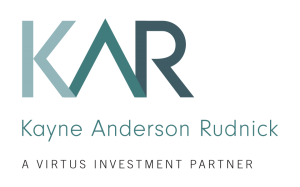
Chris Armbruster, CFA
Portfolio Manager and Senior Research Analyst
Kayne Anderson Rudnick
KAR portfolio manager Chris Armbruster discusses the performance of mid-cap equities in the second quarter, primary contributors and detractors in the KAR Mid-Cap Growth strategy, and the current AI-driven performance discrepancy between mega cap tech and smaller-cap stocks.
Listen Now
Transcript
BEN FALCONE: Hello, this is Ben Falcone, managing director with Kayne Anderson Rudnick, and with me today, I have Chris Armbruster, portfolio manager of the Kayne Anderson Rudnick Mid Cap Growth strategy. Welcome, Chris. Chris, market returns were much narrower again in the second quarter with the S&P 500® and Russell 1000® Growth meaningfully positive while small and mid-caps positive but relatively underperforming. Can you provide our listeners with your perspective on markets as we're at the halfway point of the year?
CHRIS ARMBRUSTER: For the quarter, the average U.S. equity was down 3%, but the S&P 500 was up 4.3%. It feels like a story that has become long in the tooth. But the fact of the matter is that the select group of mega-cap names that are driving the market returns are businesses at the top of their respective games, with strong fundamentals and, for the most part, bulletproof balance sheets. The top 10 S&P stocks accounted for almost 40% of the index and drove nearly 80% of its performance. But the fact remains that the largest companies are actually growing earnings more than twice as fast as the rest of the S&P 500. So, if you adjust for that earnings growth, they are, in reality, cheaper than the S&P 493 on a P/E-to-growth ratio. Strength in the fundamentals of these businesses are the true driver.
One additional thought worth considering when understanding the discrepancy between large cap and small cap is the macro. For smaller companies, the availability of capital has declined, and its cost has increased. Value-conscious consumers and small businesses are disproportionately affected by the current environment, and smaller companies tend to over-index to these customers. Acknowledging that this discrepancy could last a while, eventually we would expect the performance to broaden out.
Currently, all of the mega-cap tech companies are pouring tens of billions into building out AI capabilities. Eventually, their management, boards, and shareholders will need a return on that investment. Monetizing these capabilities will, in theory, allow other companies to either accelerate revenue growth or streamline expenses, both of which could help accelerate their earnings growth and translate into better stock performance.
BEN FALCONE: Chris, would you say fundamentals and earnings are driving performance so far this year, or has it been the change in interest rate expectations along with AI exuberance?
CHRIS ARMBRUSTER: I would say that these things are not mutually exclusive, especially for the large-cap companies that have driven the performance of many major indices. AI exuberance has definitely increased but so have the fundamentals of these businesses.
BEN FALCONE: Chris, can you discuss a few of the portfolio holdings that were key contributors and detractors to performance for the second quarter?
CHRIS ARMBRUSTER: The top five contributors to the Mid Cap Growth portfolio this quarter are FICO score creator Fair Isaac, electrification enabler Amphenol, Teradyne, Trade Desk, and Latin and South American e-commerce and fintech platform, MercadoLibre.
The name we would like to spend a little more time with this quarter is Amphenol. Founded all the way back in 1932, Amphenol has grown to be one of the largest providers of interconnects in the world. Anything that requires electricity needs connectors to deliver that electricity to the relevant components of the system. Over the years, Amphenol has put together an expansive portfolio of capabilities that spans nearly every industry where no one vertical makes up more than 25% of revenue. Its fragmented customer base demands low volume and works with Amphenol to design its solutions into products, creating long cycles and high switching costs.
Additionally, interconnects represent a small cost of the total bill of goods but have a high cost of failure, so products are selected on performance rather than price. In our view. Amphenol runs an efficient business, generating high amounts of free cash and using it to add capabilities to its portfolio by accretively rolling up smaller players or repurchasing shares.
The recent run in the shares has been driven by excitement about the role Amphenol will play in the build out of AI capabilities. The servers and networking within a data center needed to power AI requires a higher density of connectors rather than traditional servers. Additionally, AI systems require connectors that can deliver on high speed, low latency, and minimal power consumption. There are few companies in the market that can deliver on those specifications as many interconnect players focus on lower tech pockets of the market.
Beyond AI, there is secular growth in electrification across industries as equipment and devices are moving away from analog and embedding more compute power. From industrial to automotive to defense and aerospace, we believe Amphenol is well positioned to enable the steady penetration of electronics in a diverse set of markets.
The bottom five detractors from the Mid Cap Growth portfolio performance for the quarter were functional energy drink provider Celsius, landscaping distributor SiteOne, ad verification platform DoubleVerify, next generation database provider MongoDB, and leading pool equipment distributor Pool Corp.
The detractor we wanted to focus on this quarter is Celsius. We believe Celsius has been a success story in terms of brand building. It started as a niche product for the fitness channel, marketing its thermogenic property as the only drink on the market with clinical studies, proving the drink increased one's metabolism and activated the nervous system to cause the body to burn more calories and body fat. With a differentiated flavor selection and health profile, it quickly gained popularity outside the fitness channel, most notably becoming the second best-selling energy drink on Amazon, overtaking more established brands that had been selling on the platform for years. Then, one of its stronger competitors ran into trouble with some intellectual property lawsuits that resulted in its key distributor dropping the brand and inking a new distribution deal with Celsius, further accelerating growth.
Currently, however, the company seems to be going through an adjustment, where after a period of hypergrowth, it is settling into a more normalized growth pattern. Its distributor is right-sizing the amount of inventory in the channel, and retailers are looking to optimize brand positioning through shelf resets. As a result, after reaching a category share over 12% earlier this year, it has fallen steadily to about 11.5% as sales growth has moderated from over 50% to around 20% while some emerging brands have outperformed.
Overall, we take comfort in the fact that not only has the energy drink category slowed, but the entire food and beverage industry more broadly has been challenged. Furthermore, promotional allowances have been stable and in line with previous years. Growth with a distribution partner like Celsius's growth partner won't be linear but is a clear long-term positive, and international launches have accelerated growth outside the United States. So, while Celsius shares have round-tripped their gains for the year, we believe the data suggests that this period is more of a breather for a strong, longer-term growth story.
BEN FALCONE: Chris, with the Fed seemingly on hold, do you think we will see more of the same in terms of market performance in the back half of this year, or do you think the market can broaden out in terms of performance if everything stays status quo?
CHRIS ARMBRUSTER: Given the durability of the forces that led to the dichotomy between large and small caps, odds are that the rest of the year looks more similar to the first half than different. The stakes are high for the mega caps in the race to stay relevant in an AI-influenced world, and they all have massive amounts of financial firepower to chase those goals.
But importantly, that doesn't mean our high-quality businesses can't perform as well. Assuming we have correctly identified businesses whose characteristics allow them to hold up better than others in the face of things like high interest rates, constrained access to capital, a slowing consumer, and weakness overseas, these businesses have the opportunity to invest to position themselves better for when tailwinds broaden out.
BEN FALCONE: Chris, as always, thanks for taking the time to provide your insight to our KayneCast listeners.
This information is being provided by Kayne Anderson Rudnick Investment Management, LLC (“KAR”) for illustrative purposes only. Information contained in this material is not intended by KAR to be interpreted as investment advice, a recommendation or solicitation to purchase securities, or a recommendation for a particular course of action and has not been updated since the date of the material, and KAR does not undertake to update the information presented should it change. This information is based on KAR’s opinions at the time of the recording of this material and are subject to change based on market activity. There is no guarantee that any forecasts made will come to pass. KAR makes no warranty as to the accuracy or reliability of the information contained herein.
Investing is subject to risk, including the risk of possible loss of principal.
Past performance is no guarantee of future results.
3722820
